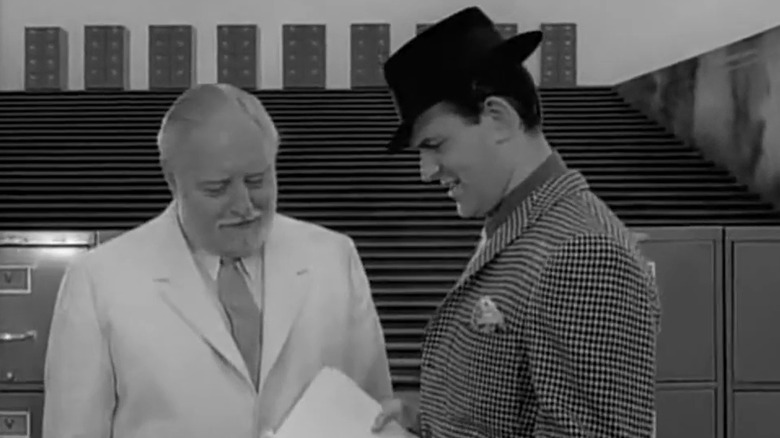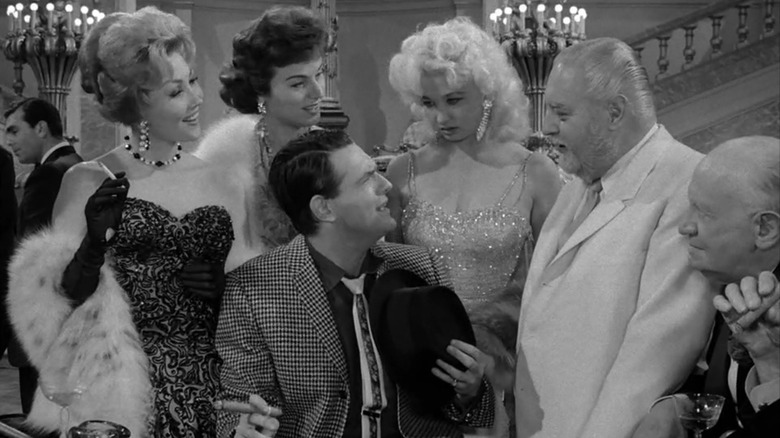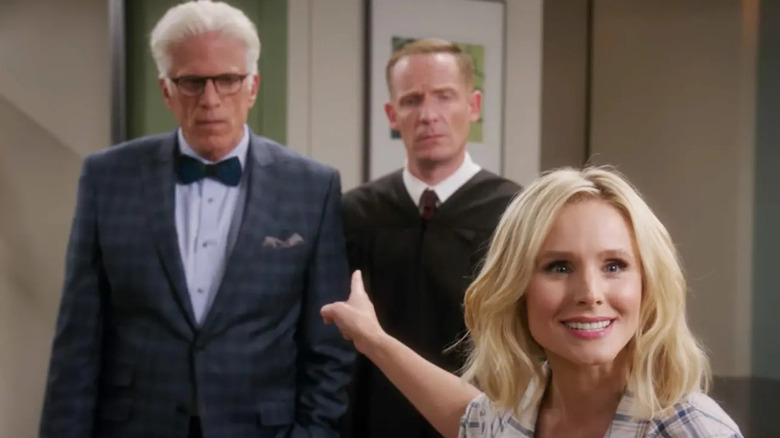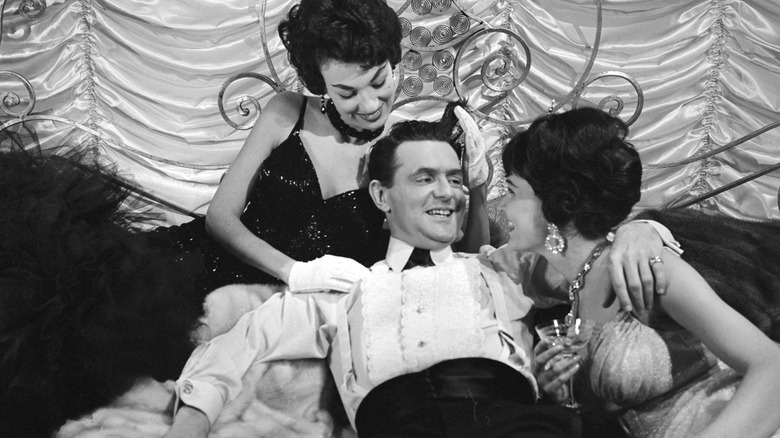One Episode Of The Twilight Zone Had The Same Twist As The Good Place
One of the best reasons to watch "The Twilight Zone" even 60 years later is that you get to see just how much each episode had an effect on pop culture. Half the episodes will make you go, "Oh, so that's what that 'Simpsons' Treehouse of Horror sketch was making fun of," or "Oh, so that's where that 'Black Mirror' episode got that idea from." Although not all of these episodes were original themselves, they still brought the source material they were based on to a national audience. Not only did the show start off with a large viewership, but constant re-runs have helped the series stay relevant for years afterward. The result is that this show constantly turns out to be a source of inspiration for so many of the best speculative TV shows and movies we have today.
Case in point: "The Good Place." The hit 2016 sitcom initially based its premise around Kristen Bell's Eleanor, a bad person who was mistakenly sent to heaven and spends the first season scheming to avoid being found out and cast down into hell. But after nine episodes of otherworldly, yet still fairly standard sitcom shenanigans, the show turns its whole premise upside down. Turns out, Eleanor was never sent to the Good Place by accident. She and the other characters have been in the Bad Place this whole time. Even the show's haters can agree that this was a pretty cool twist, one that transformed the show into must-see TV and sent the series traversing through increasingly fascinating, complicated high-concept storylines. But as it turns out, the writers may not have come up with this twist on their own.
'A Nice Place to Visit'
The season 1 "Twilight Zone" episode "A Nice Place to Visit" centers around Rocky (Larry Blyden), a criminal who's shot down in a burglary gone wrong. He's visited by an apparent angel Pip (Sebastian Cabot), who takes him to a place that sure seems like heaven. Here he's rich, surrounded by beautiful dames, and he keeps winning at gambling over and over again. But as he keeps getting everything he wants with zero struggle, zero effort required, Rocky grows bored and frustrated. He also starts wondering what he even did to deserve all this good fortune. "You don't think there's been some mistake, do you?" he asks Pip, and Pip keeps assuring him that this wouldn't be possible.
By the end, Rocky gets so frustrated that he even asks Pip to take him to "the other place," figuring that even a pain-filled hell would be preferable to this dull paradise. That's when the affable Pip suddenly drops the mask and says, "Whatever gave you the idea you were in heaven, Mr. Valentine? This is the other place." As Pip bursts into maniacal laughter, the episode ends with host Rod Serling's narration explaining how Rocky will be trapped in this place forever, tortured with getting everything he ever wanted for the rest of eternity.
Watching the episode, it's hard not to see the blueprints for the season 1 finale of "The Good Place." The 2016 episode even ends with a similarly, dark haunting ending, with Ted Danson's false angel even giving his own maniacal laugh; if the show had been cancelled after season 1, it would've ended with the implication that Eleanor was trapped in a cycle of losing her memory and being tortured in The Bad Place for eternity, too.
Where it differs
"The Good Place" showrunner Michael Schur has never claimed "A Nice Place to Visit" as his inspiration for the show, which is more believable than it sounds. Just by virtue of being a long-running sitcom instead of a standalone episode, there's more than enough going on in "The Good Place" to easily beat any copycat allegations. The big difference is that Eleanor, as bad as she was in her life, is at least self-aware enough to immediately know she doesn't belong in this heaven. Rocky, meanwhile, doesn't assume there's been a mistake. He takes Pip at his word that he's in heaven, which creates a somewhat frustrating experience for modern audiences as we wait for him to finally figure out what's going on.
Rather than "The Twilight Zone," Schur has instead pointed to Jean-Paul Sartre's 1944 play "No Exit," which presents a version of hell in which three people are trapped in a room together for all of eternity, with nothing left to do except drive each other mad. "Hell is other people," is the play's most famous line, and it's sure easy to see how the first season of "The Good Place" had fun playing around with that idea.
But because Michael Schur is fundamentally an optimist — and because most viewers wouldn't want to watch a show that's nonstop misery — "The Good Place" ends up turning the phrase on its head. The four main characters may have spent the first season driving themselves mad, but ultimately they realize that they are in fact pushing each other to become better people. So although you can trace "The Good Place" back to either "No Exit" or "The Twilight Zone," it's certainly proven itself as its own special thing.
Where it stays the same
The main inspiration the show takes from "A Nice Place to Visit" (intentionally or otherwise) is not the twist about being in hell, but the exploration of the idea that heaven, in the way most people understand it, isn't actually as good as it seems. It may sound nice to live in a nice happy place where nothing bad ever happens and you've got everything you could ever want forever and ever, but most likely, you will get bored of all this within a month or so. If you let people reconnect with their old friends and family members, as they do in the end of "The Good Place," you can probably delay this boredom a lot longer, but it'll still come eventually.
"The Good Place" offers a solution to this: letting the afterlife end whenever the person decides they want to go. The show argues that things always need to have an ending for any of it to feel like it has meaning, which is definitely the underrated factor behind the horror in both "No Exit" and "A Nice Place to Visit." Rocky's punishment isn't horrible because there's no real struggle anymore; it's horrible because there's no real struggle forever, and that horror would eventually reveal itself even if the struggle came back. The Bad Place reveal might be the most obvious element in common with "A Nice Place to Visit," but it's with its dwellings on eternity that the 1960 episode's influences really shine through.



